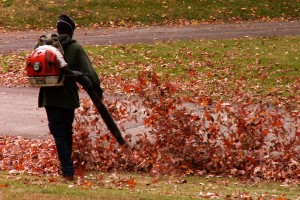 Fall leaves are beautiful when they’re still on trees, but they become a major nuisance and a threat to your lawn when they start falling. A leaf blower can make leaf removal fast and easy, but only if you know the right techniques. These tips will help you get the most out of your equipment whether you have a Honda-powered backpack or walk-behind blower, an older Honda-built blower or a blower attachment for your VersAttach multitool.
Fall leaves are beautiful when they’re still on trees, but they become a major nuisance and a threat to your lawn when they start falling. A leaf blower can make leaf removal fast and easy, but only if you know the right techniques. These tips will help you get the most out of your equipment whether you have a Honda-powered backpack or walk-behind blower, an older Honda-built blower or a blower attachment for your VersAttach multitool.Be Sensible About Safety and Considerate to Your Neighbors
A blower works by moving air so fast that it can push heavy, loose materials. That means lots of noise and dust that requires eye and ear protection. It’s also a good idea to stay well away from gravel driveways and to wait a while before blowing over areas that have recently been covered in fertilizer, pesticides or other chemicals.
Speaking of dust and loudness, you should probably limit blowing to times when everyone is awake and no one is out playing in the yard or having a barbecue.
Work with the Weather
Working on a wind-free day will keep the leaves you just moved from blowing away, but if you must work when it’s windy, plan accordingly by working toward the wind direction instead of against it.
Wet leaves are far heavier than dry leaves and tend to clump together, making them even harder to move. Unless absolutely necessary, only blow leaves when they’re dry.
Plan Where You Want the Leaves to Land
Place a tarp in an area that is easy to reach both for the blower and their final destination, whether they’ll be loaded into bags or onto a trailer. Once everything is in place, start working from the outer edges of the property toward this tarp.
Live at the edge of a forest? While it may seem like a good idea to simply blow the leaves into the woods, tall piles of leaves can collect moisture that will promote rot, hurting and even killing the trees. This is especially true in areas with acidic soil including the East, Southeast and Pacific Northwest where the decomposing leaves can push the pH to plant-damaging levels.
Use the Right Angle
Pointing the tip down will concentrate the jet of air into a small spot, which is ideal for pulling up matted leaves and mulch. However, this also pushes the leaves higher into the air where they can be caught by the wind, blowing them where you don’t want them, and it will lift more dust off of the soil.
Using the tip at a shallow angle will move the leaves forward instead of up, making them easier to maneuver and collect into a pile. Skimming the surface will also keep dust from being blown up.
Don’t Expect Perfection
A leaf blower can remove 99.5% of the leaves from your lawn with ease, but there will always be a handful of leaves that will stick tenaciously to the grass. Unless you have a section that has clumped together, it’s better to leave them alone. With the vast majority of leaves removed, you’ve accomplished the three main reasons for moving leaves: maintaining drainage, exposing the grass and preventing an increase in surface soil acidity.
Use the Blower for More than Leaves
A blower works great for moving light snowfall and water off of driveways and pushing away cobwebs that gather on the corners of buildings.
Keep Your Blower Working
When you need parts for Honda blowers or engines, visit www.hondalawnparts.com. We’re a certified Honda Small Engine Equipment dealer, which means we carry everything for their motors and equipment. Our site has factory diagrams built in to help you find the part you’re looking for, and we can ship it to you whether you live in the U.S. or Canada.
